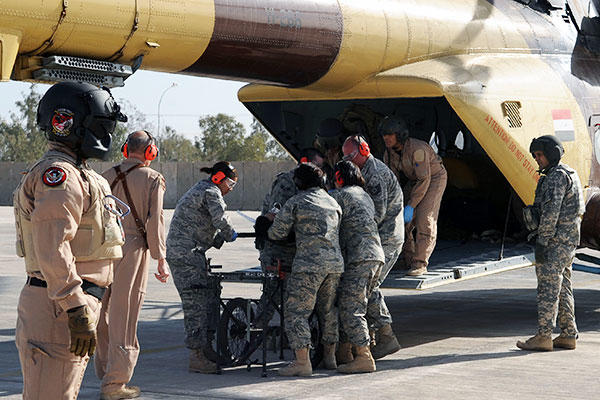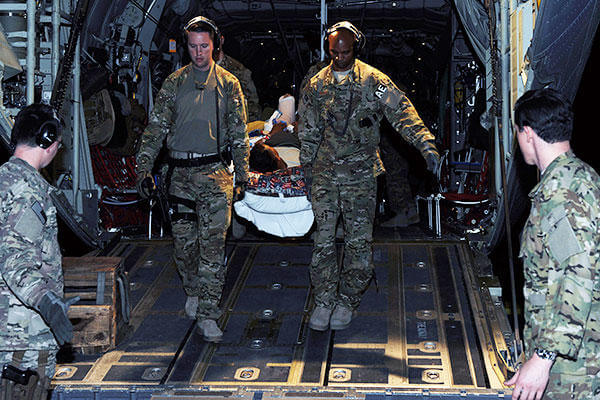The Air Force is committed to research and development for advancements in en route patient care.
The Air Mobility Command Surgeon General's office and researchers across the Air Force, to include the 711th Human Resource Wing at Wright Patterson Air Force Base, Ohio, have been working together to improve how the Air Force provides care in the air. The AMC/SG is responsible for clinical oversight of the Air Force aeromedical evacuation (AE) system.
"Over the last 15 years, the joint community has made tremendous strides in providing care to our wounded warriors," said Col. Susan Dukes, the En Route Care Research Division chief for the Air Force School of Aerospace Medicine at Wright Patterson AFB.
"We now have programs of research specific to en route care. It's very important to clinicians and researchers to capture lessons learned in order to improve our policies and procedures for patient care," Dukes added.
About every 12 to18 months, AMC conducts a capability based assessment which informs the surgeon general's office where gaps are across the en route care spectrum. Gaps are categorized in areas such as doctrine, personnel, and facilities, and assist AMC/SG with focusing its research efforts, said Col. Andrea Gooden, the En route Medical Care Division chief for AMC/SG.
Many of the questions asked by researchers require a series of studies to reach an evidence-based approach that informs policy or changes clinical practice, Dukes said.
Researchers are studying the stresses of flight and the various impacts of transport, such as hypoxia and vibration, she said. Findings from these studies will help identify what needs to be done differently while caring for patients in the en route care system compared to care provided to patients in the hospital environment.
Dukes said over the years, another aspect of researched care has been pain control. Research has shown that if severe pain is not controlled early on, it can lead to problems with chronic pain. Controlling severe pain following devastating injuries has also been suggested to protect against the development of post-traumatic stress syndrome.
"The Air Force is trying to look at better ways to manage pain within the en route care system," Dukes said. "Identifying pain management challenges was the first step. We are now looking at interventions, to include the use of regional anesthesia for our critical care and AE patients. We are also researching diversion and music therapy as non-pharmacological measures for pain control in our non-critical patients."
She said studies have been completed by other researchers to assess the effectiveness of alternative pain management methods, such as acupuncture.
Another documented research gap is the need to understand the relationship between the time of the injury and the time to transport. A study recently released by researchers at the University Of Maryland School Of Medicine revealed evidence suggesting air evacuations of traumatic brain injury (TBI) patients may pose a significant added risk, potentially causing additional damage to already injured brains. Identifying the impact of transport and the best time to transport patients with different disease processes or injuries are questions military researchers have been studying for several years, Dukes said.
This study was looking at the timing of simulated transport with different amounts of oxygen administered using an animal model, Dukes noted. Additional studies are needed before these findings can be applied to policy.
"We are taking it into consideration as we look at how we care for our TBI patients," Gooden said. "Our flight surgeons evaluate each patient individually as they are validated for movement. We are taking the research seriously, but we really need to replicate in a human model before we change policy."
The Defense Department is also developing a new electronic health record to be pushed across all services soon. The AMC Surgeon General's office aims to provide a solution to the disconnect between ground medical capabilities to the AE capability, Gooden said. Currently, there is an electronic record of care received on the ground, but not in the air.
"If you consider where you are taking off from and what agencies are delivering the patient and then subsequently receiving the patients, if they are not all using the same program, it quickly becomes complex," said Lt. Col. William Thoms, the aeromedical evacuation clinical operations chief for AMC/SG. "When we land to pick up our patients, AE and critical care teams need to be able to receive the data seamlessly to provide further positive outcomes."
The goal is for the AE crews to be able to telecommute or reach out to communicate to ground sources, he said. This will enable the providers on the ground to give AE personnel definitive and clear guidance on how to take care of any crisis taking place in the air.
How AE Airmen train also plays in an integral role in operational readiness and improved care. AMC/SG recently led a high performance team focused on clinical sustainment training for AE, patient staging and critical care. The results identified research is needed on the use and effectiveness of simulation in clinical training.
"Our number one priority is incorporating simulation into our clinical training requirements," Gooden said. "We are trying to incorporate and standardize training across the total force: AE, patient staging and critical care elements. Eventually having the ability to cross train the services would benefit every en route care node."
For instance, the command is hoping to create clinical training centers for excellence which would include en route care research along with the AE, patient staging and critical care disciplines, said Lt. Col. James Speight, the chief of AE clinical training for AMC/SG.
The research lab is looking at using virtual environments, gaming and personalized training to keep AE members proficient.
"We are hoping to understand how much simulation is effective to properly train the critical care, AE and patient staging personnel," Speight said.
It is a huge undertaking to standardize simulation training across the spectrum, he said.
"There's an initiative moving forward to incorporate training and networking across the services because, when we look at the en route care system, it's not just the Air Force," Speight said. "We have initiatives underway to help provide standardized integrated training and preparation so the entire en route care process can be as safe as possible for our patients."
The DOD, through many initiatives, has improved the survival rate of wounded warriors since the advent of operations in U.S. Central Command. Continually improving care through the use of evidence-based practice is a key area supporting these improvements. As a result of research and innovative training, care in the air will continue to improve in the future.




























